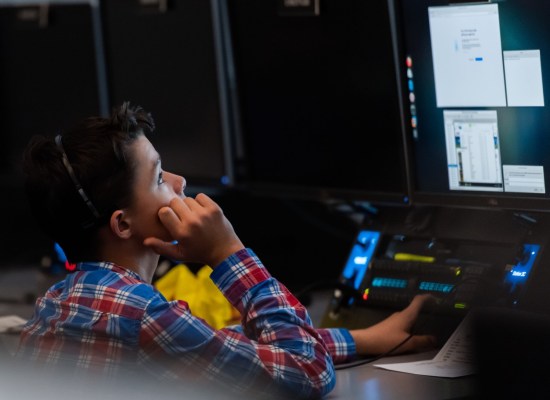A growing effort to attract more women and people of color into the space industry has shared some of its first results and a new occasion to rally around: National Space Day, May 3, when thousands of students will learn that not only can they do space stuff, but they really should start now.
Space Workforce 2030 is a joint effort by the Space Foundation and Aerospace Corporation, amounting to basically a promise that they — and all their 29 company partners as of now — will transparently report the demographics of their workplaces, hiring and recruitment, and work together to identify ways to bring a more diverse crowd to the notoriously homogeneous space industry.
The effort also now has an executive director in Melanie Stricklan, formerly of Slingshot Space (and the Air Force), who is now leading the organization full time.
In an announcement Monday, Stricklan and colleagues from Aerospace, Space Foundation and Airbus U.S. showed a few key statistics they’re hoping to bump up: not just endpoints like a diverse workforce, but an inclusive labor pipeline that anyone with interest in the industry can take part in.
Stricklan and the others presented a united front that this isn’t some surface-level DEI thing — the aerospace industry may face a labor crisis in the coming years as one generation retires and another doesn’t really step into its place.
“When we think about our nation’s IP and leadership globally, it’s synonymous with leadership in space,” Stricklan told me in an interview before the occasion. “We need the best workforce out there, and we are looking to build the best talent base in the world. This isn’t quota-driven; the best space workforce in the world comes from a perspective of meritocracy.”
In other words, they strongly support the view that diversity on the supply side of the labor funnel leads to a stronger workforce on the other end.
To that end Space Workforce 2030 has started with the basics: collecting and understanding the data in order to establish a baseline. They’ve leaned on Aerospace’s research analysis prowess to handle the incoming data from dozens of companies that are taking part in the initiative, standardizing it and producing results they can reliably compare year to year. This in itself is an accomplishment, it must be said — these aren’t companies known for their openness and transparency. But as Airbus US’s Robert Geckle pointed out, they see workforce collapse as a serious, long-term threat that needs serious, long-term solutions.
The initial numbers show modest increases and some troubling misses — which is more or less what you’d expect from the first real year of this organization in action. From 2022 to 2023, the proportion of female technical staff rose from 18.5% to 19.4%, while the proportion of people of color in that category rose from 32.7% to 34.1%. Applications for internships rose by factor of 10!
On the other hand, the number of women in actual internships with the industry stayed flat, while the number of women converted from intern to staff went down a whopping 4.5%. You can read the rest of the top-line statistics in the report itself.
So the question is: why? Were these small gains meaningful and the result of efforts at these companies? What explains the drop in women interns, but the increase in applications?
There isn’t really a solid answer, because the reality is this data is only just now starting to be collected and investigated. A big part of the commitment is simply making these numbers available so that everyone can be honest and collaborative about where there are improvements to be made. It’s only if multiple companies and organizations are publicly sharing this data that the group can say: wait, this company has been steadily improving its intern conversions for a few years now — what are they doing right? This would hopefully then arm the other companies with actionable intelligence.
A big part of the challenge of getting people into the space is letting people know that it’s even an option, and Stricklan and her colleagues firmly believe that this includes the K-12 segment, not just college kids and job seekers. So they’ve organized a National Space Day curriculum with videos, information for teachers and a bunch of other material intended to show kids of all ages and backgrounds that yes, they can build satellites, rockets, lunar landers, maybe even go to space themselves.
It’s May 3, and they’ve enlisted the help of former TechCrunch collaborator Emily Calandrelli (who is great) to create and promote content for the occasion. Stricklan told me that thousands of teachers have signed on and they expect to see a lot of engagement next month.
Amazingly, Congress even got its act together long enough to propose a resolution to honor National Space Day. Hopefully they can agree that this is not the kind of thing partisan bickering should derail.
The Space Workforce 2030 leaders and partners all emphasized that this is a long-term effort that is only just beginning — hence the focus on kids who won’t be eligible for internships for a decade or more. That also means that they have yet to pull a lot of levers to improve their outcomes and add more data to the pile.
“One thing I’d like to do is extend to government organizations as well as nonprofit affiliates. They have different touchpoints to get to those that just don’t understand there could be a future for them in a STEM-related career,” Stricklan told me. She mentioned the Office of Management and Budget (which has tons of data), NOAA and the EPA (tons of interesting jobs) and several others that they’re in talks with or looking to approach.
It’s good to see a clear-eyed acknowledgement that we could face a talent crisis in space and adjacent industries — and a willingness to admit there’s a lot of work to do. You can learn more about the Space Workforce 2030 effort here.
